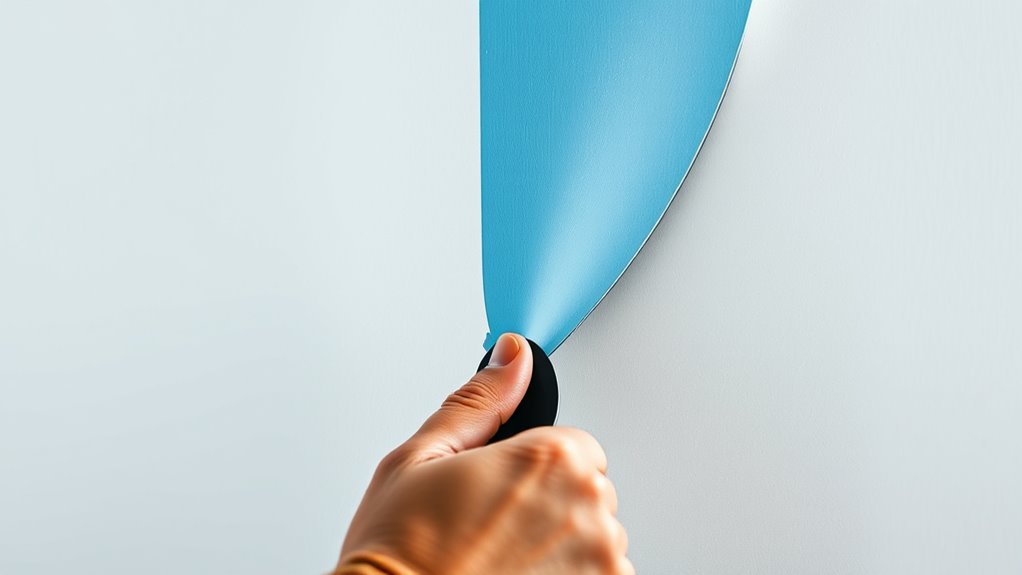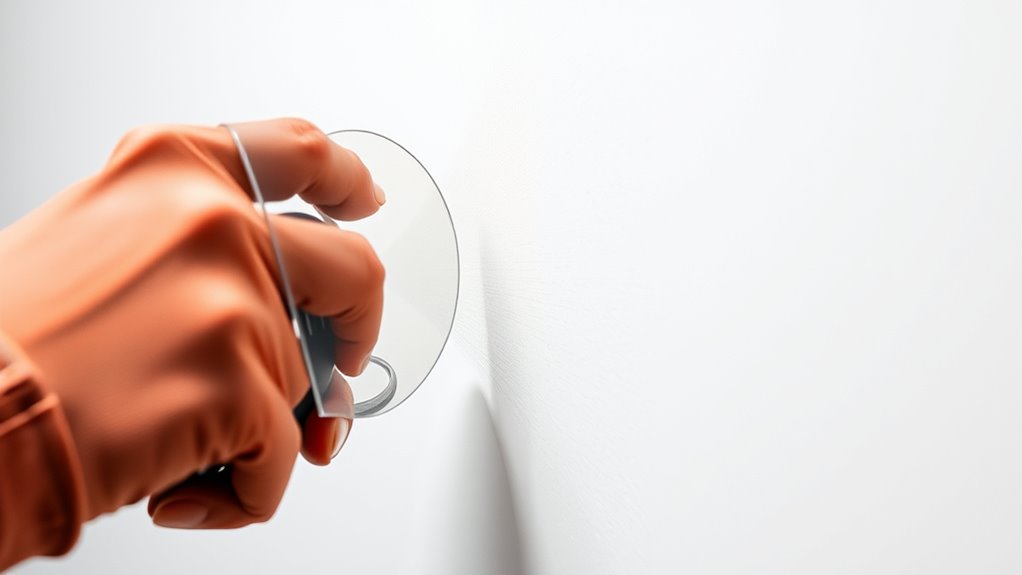Using spray shields helps you achieve clean, sharp paint lines by controlling overspray and guiding your spray gun precisely. Keep the shield close enough to block unwanted paint while maintaining a steady, even motion. Adjust your spray gun tips for the best pattern, and use the shield as a physical guide for masking. Proper technique and tool setup are key to perfect results. Stay with us to discover more tips for flawless finish lines.
Key Takeaways
- Keep spray shield close to the surface to block overspray without interfering with the spray pattern.
- Maintain steady, even strokes while guiding the spray shield for consistent, sharp paint lines.
- Properly adjust your spray gun for a suitable pattern before applying the shield for optimal results.
- Use the shield as a physical guide to improve masking accuracy and prevent paint bleeding.
- Combine the spray shield with correct technique and controlled movements for professional, clean edges.

Achieving crisp, clean paint lines can be challenging without the right tools, but spray shields make the process much easier. When you’re aiming for sharp edges and professional-looking results, mastering masking techniques is vital. Spray shields act as a barrier that helps you control overspray and keep paint confined to your target area. This way, you don’t have to spend extra time cleaning up mistakes or worrying about paint bleeding onto unwanted surfaces. Using a spray shield effectively allows you to focus on your technique and achieve precise lines without the hassle.
Spray shields help control overspray and achieve professional paint lines with ease.
One of the biggest advantages of spray shields is how they help you work efficiently. Instead of meticulously taping off every edge—an often time-consuming and imperfect process—they provide a quick, reusable barrier. As you hold the spray shield in place, you can direct your spray gun tips at the target surface, ensuring paint only goes where you want it. This method reduces the need for multiple coats and touch-ups, saving you both time and paint. Plus, spray shields are versatile; you can find models that are adjustable or flexible, allowing you to adapt to different shapes and surfaces.
When using spray gun tips, it’s vital to keep your movements steady and consistent. The spray shield allows you to maintain a safe distance from the surface, preventing accidental overspray that can blur your lines. As you work, keep your strokes even and controlled—this will help your paint flow smoothly and evenly. Remember, the key to clean lines is not just in the tools but in your technique. A spray shield helps you implement your masking techniques more effectively by acting as a physical guide, so your hand doesn’t have to be perfectly steady all the time. Additionally, choosing the right essential oil can promote a calm and focused mindset during detailed work.
Another tip is to guarantee your spray gun tips are properly adjusted before you start your project. Proper spray gun tips help achieve the desired finish and prevent paint from splattering or running. Combine that with a spray shield, and you create a setup that promotes accuracy. Keep the shield close enough to the surface to block overspray but not so close that it interferes with your spray pattern. It’s all about finding the right balance. As you gain experience, you’ll find that spray shields become an indispensable part of your painting arsenal, especially when precision matters.
Frequently Asked Questions
Can Spray Shields Be Reused Multiple Times?
Yes, spray shields can be reused multiple times if you clean them properly after each use. To get the best results, follow paint job tips like rinsing shields thoroughly and avoiding harsh cleaners that could damage the material. Proper maintenance guarantees your spray techniques stay effective, and you can reuse your spray shields for many projects, saving you time and money while achieving those clean, sharp lines every time.
What Materials Are Best for Spray Shields?
If you want your spray shield to survive the chaos, go for sturdy materials like plastic or metal. Plastic options like polyethylene are lightweight, but beware—they might crack under pressure. Metal shields are durable but heavier. Consider durability when choosing, so your shield keeps up with your painting adventures. Ultimately, pick materials that balance flexibility and strength, ensuring you get clean lines without sacrificing your sanity or your shield’s lifespan.
How Do I Clean Spray Shields After Use?
After use, you should clean your spray shields with brush cleaning to remove any leftover paint or debris. Rinse them thoroughly with water or an appropriate solvent, depending on the paint type. Once clean, dry them completely to prevent rust or damage. For storage tips, keep your spray shields in a dry, protected area, ideally hung up or stored flat, so they maintain their shape and stay ready for your next project.
Are Spray Shields Suitable for All Types of Paint?
Spray shields are versatile, but their suitability depends on paint compatibility. They work well with latex, acrylic, and oil-based paints, offering good protection and clean lines. However, some specialty paints or thick coatings might not be ideal, as they can cause overspray or damage the shield. Always check the spray shield’s material and manufacturer’s recommendations to ascertain the best results with your specific type of paint.
Can Spray Shields Be Used Outdoors Effectively?
Yes, spray shields can be used outdoors effectively, but you should consider outdoor weather conditions like wind, humidity, and rain that can affect your results. Opt for a portable spray shield to easily move and adapt to changing weather. Make sure to choose a shield that’s lightweight and durable for outdoor use, and always check the forecast to avoid painting in unfavorable conditions for the best, clean lines.
Conclusion
Using spray shields is like painting a straight line in a crowded room—you maintain control and prevent messes. I once watched a friend carefully apply spray paint with a shield, and the result was flawless, like a master’s stroke. Remember, precision with tools like spray shields isn’t just about neatness; it’s about taking charge of your project and turning chaos into clarity. When you master this simple technique, you’re one step closer to professional-quality results every time.










